Kurt Nassau and the Fifteen Causes of Color
Steven Dutch, Professor Emeritus, Natural and Applied Sciences, University of Wisconsin - Green Bay
Few questions are as seemingly simple, yet as deeply complex, as "why is it that color?" Kurt Nassau's classic book The Physics and Chemistry of Color: The Fiftssn Causes of Color identifies five broad categories of causes, subdivided into fifteen types:
- Vibrations and Simple Excitations
- Incandescence: flames, star colors, molten steel
- Gas Excitations: Auroras, neon lights
- Vibrations and rotations: blue ice and water colors, blue gas flames
- Transitions Involving Ligand Field Effects
- Transition Metal Compounds (Idiochromatic Colors)
- Transition Metal Impurities (Allochromatic Colors)
- Transitions Between Molecular Orbitals
- Organic Compounds: Hemoglobin, Chlorophyll
- Charge Transfer:
- Translations Involving Energy Bands
- Metals: Gold, Silver, Copper
- Pure Semiconductors: Silicon, Galena, Cinnabar, Sulfur, Diamond
- Doped or Impure Semiconductors: Colored Diamond, Light-emitting Diodes
- Color Centers: Amethyst, Smoky Quartz, Blue Halite
- Geometrical and Physical Optics
- Dispersive Refraction: Rainbows, Haloes, Green Flash, Fire in Gems
- Scattering: Blue Sky, Almost All White Materials
- Interference: Oil Films on Water, Iridescence of Shells, Soap Bubbles
- Diffraction: Glory (Specter of the Brocken), Diffraction Gratings, Opal
Vibrations and Simple Excitations These are perhaps the conceptually simplest causes of color. Atoms either are collectively excited to produce light (incandescent) or emit light individually (gas excitations) or as molecules (vibrations and rotations).
Transitions Involving Ligand Field EffectsColors are emitted by atoms within solids, but the colors are affected by the effects of neighboring atoms on the energy levels of the atoms. Thus the same impurity - chromium - makes ruby red and emerald green.
Transitions Between Molecular Orbitals These are colors created by electrons that orbit multiple atoms, or by electrons that jump from one atom to another
Translations Involving Energy Bands are interactions at the opposite extreme from simple excitations. In materials with energy bands, all the outer electrons in a material interact, creating energy bands where every possible photon can interact with electrons. Color centers are a different case, involving electron vacancies or extra electrons that create energy levels capable of absorbing or emitting light.
Geometrical and Physical Optics are effects that have nothing to do with interactions with atoms (except the general interactions involving reflection or refraction). Instead, color is created by the interactions between light waves themselves.
Vibrations and Simple Excitations
Incandescence:
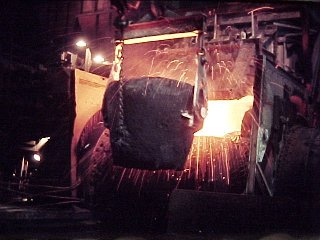 |
Slag being skimmed off a crucible in the smelter at Sudbury, Ontario. The slag emits light because it's hot and the specific wavelengths are directly related to temperature. Because it's a long exposure, drops of spattered slag leave streaks. Fun fact: if one of those drops is the same color and brightness as, say, Betelgeuse, they are the same angular size. |
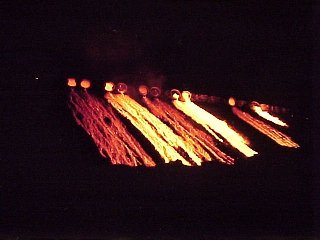 |
A slag dumping at night. Note how the color changes to red as the slag cools |
 |
Flames emit nearly black body radiation. Incomplete combustion creates tiny soot particles which are heated to incandescence. The smoke is suspended soot particles that have cooled below incandescence. |
Gas Excitations:
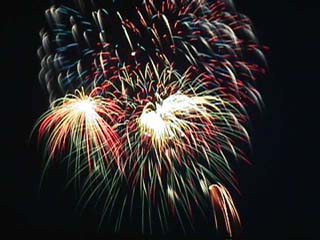 |
White is produced by extremely hot magnesium (incandescence) but colors are due to emissions by copper, strontium, and other atoms. |
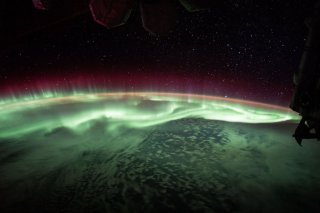 |
The aurora is caused by charged particles exciting atoms in the upper atmosphere. |
| The yellowish green band above the earth is airglow, a form of chemiluminescence from excited oxygen molecules. The brilliant white light is lightning illuminating clouds and the red streaks above it are sprites, electrical discharges in the upper atmosphere. The yellow splotches are cities illuminated by sodium vapor lights. Pretty much everything in this picture is some form of gas excitation. |
Vibrations and Rotations:
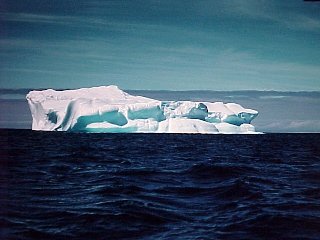 |
Ice and water really are blue. Vibrations of water molecules absorb mostly infrared, but a tiny amount slops into the visible spectrum, so substantial thicknesses of ice and water actually are blue in color. |
 |
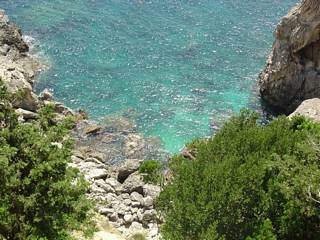 |
Transitions Involving Ligand Field Effects
Transition Metal Compounds (Idiochromatic Colors)
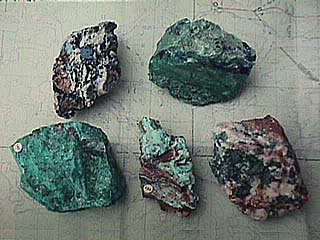 |
Copper minerals owe their famous green and blue colors specifically to copper. |
Transition Metal Impurities (Allochromatic Colors)
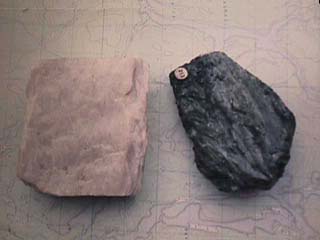 |
Tremolite (left) and actinolite (right) are essentially the same mineral and form a continuous series, but the magnesium end member, tremolite (left), doesn't contain any transition metals whereas actinolite (right) contains iron. |
Transitions Between Molecular Orbitals
Organic Compounds:
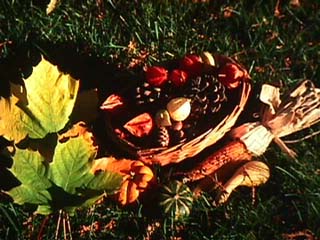 |
Most plant colors owe their hues to molecular orbitals |
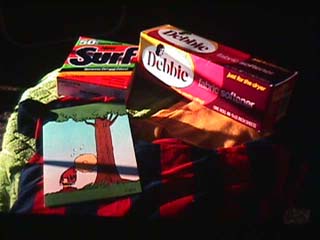 |
Most of our dyes are also molecular orbital colors. We first learned to do this in the mid 19th century, but it was hit or miss until we discovered the mechanisms that make it possible. |
Charge Transfer:
 |
The only transition metal among the most abundant elements is iron, which is far and away the most important colorant in rocks, minerals and soils. Ferric (+3) iron involves charge transfer with oxygen atoms, and ferrous (+2) typically inolves charge transfer with ferric (+3) iron. Depending on concentration, ferric iron creates "earth tone" colors from pale yellow or pink to dark brown or black. Ferrous iron tends to create deep green or black colors. |
Translations Involving Energy Bands
Energy bands describe the appearance of substances with free electrons. In metals, there are already free electrons, plus vacant energy levels. In semiconductors, electrons are all bound to the constutuent atoms (the valence band), but electrons can be raised to some of the vacant free electron energy levels (the conduction band).
Metals:
Metals can be thought of as positive ions held together by a negative electron "gas." The free electrons are all essentially identical, hence have to spread out among different energy levels. Above the highest energy free electrons, there are unoccupied energy levels. Thus, any photon can find an electron to excite, so metals absorb light and are highly reflective.
Pure Semiconductors:
Semiconductors have all their electrons bound to their constituent atoms, but there are also higher energy levels where some electrons can become free electrons.
 |
In diamond, the gap between the bound electrons (the valence band) and the free electrons (the conduction band) is too great for visible light to excite electrons. Diamonds are therefore clear when they are pure. |
 |
Sulfur and sulfides with bright colors are medium band-gap semiconductors. They absorb blue and violet but transmit red and yellow. |
 |
Pyrite is a narrow band-gap semiconductor and all visible light can kick electrons between the valence and conduction bands, so optically it acts like a metal. |
 |
Who doesn't love stibnite? It, too, is a narrow band-gap semiconductor. |
Doped or Impure Semiconductors:
Doped semiconductors are those where an impurity atom can accept electrons from the valence band, or supply electrons to the conduction band. There aren't that many natural examples apart from diamond, but artificial examples are the beckbone of our solid state electronics.
Color Centers
 |
Smoky quartz forms when quartz contains a small amount of aluminum. Protons occupy interstitial spaces to make up for the fact that Al only has a +3 charge. Irradiation strips an electron off an oxygen atom to create a hydrogen atom, and the depleted oxygen atom becomes a color center that can absorb light. |
Geometrical and Physical Optics
Dispersive Refraction:
 |
Rainbows are one of the best known examples of dispersion. |
 |
This brilliant solar halo and sun dog are created by fine wind-blown snow. |
Scattering:
 |
The blue sky is due to Rayleigh scattering, the crepuscular rays to Mie scattering, and the clouds are visible because of multiple scattering. The yellow near the horizon is due to greater absorption of blue by the greater thickness of atmosphere. |
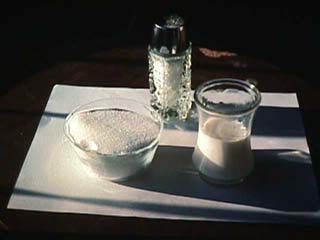 |
White is the one color that we can assign mostly to a single mechanism. Most whites are due to scattering. And don't give me that nonsense about "white isn't a color." If you can buy it in a bucket of paint, it's a color. |
Interference:
 |
"Iridescent" colors like this beetle are most likely due to some kind of interference. Diffraction colors would change with direction, but hues that remain constant are mostly interference. |
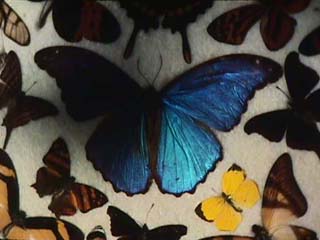 |
The brilliant blue of a Morpho butterfly isn't due to diffraction, as often thought, but to interference. |
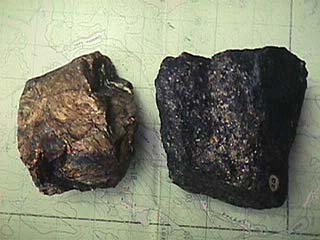 |
Iridescent films on metallic minerals are due to a thin oxide layer. |
Diffraction:
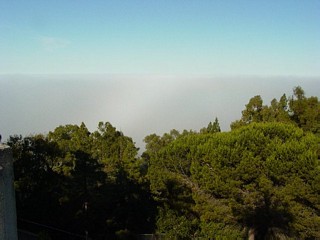 |
The slanting white band is a fogbow. It's formed like a rainbow, except the fog droplets are so tiny diffraction washes out all the color. |
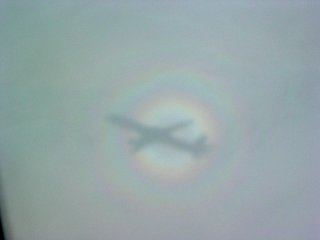 |
The "glory" or "Specter of the Brocken" is a diffraction and interference phenomenon. It appears only on water droplet clouds and the colored rings vary in size with droplet size. Several different rival mechanisms have been proposed. |
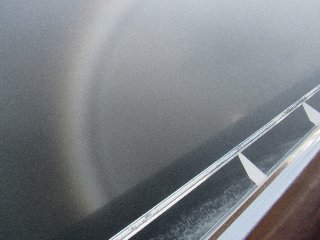 |
A fogbow and glory, taken from a ship in Alaska. The fog is so wet the droplets are big enough to show some dispersion. The supernumerary arcs within the bow are due to diffraction. The glory is the tiny colored halo at the center of the fogbow arc. |
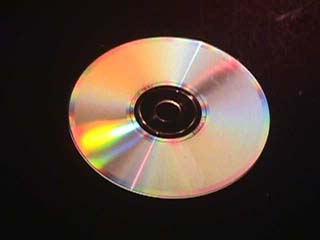 |
Compact discs are a now-ubiquitous case of diffraction colors. |
Atoms and Light
Causes of Color: Incandescence and Simple Excitations
Causes of Color: Energy Bands
Causes of Color: Ligand Fields
Causes of Color: Molecular Orbitals and Charge Transfer
Causes of Color: Physical Optics
Return to Mineralogy-Petrology Index
Return to Thin-Section Index
Return to Crystals and Light Index
Return to Crystal Structures Index
Return to Mineral Identification Tables
Return to Professor Dutch's Home Page
Created 27 February, 2019, Last Update